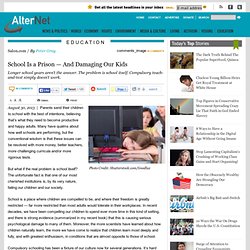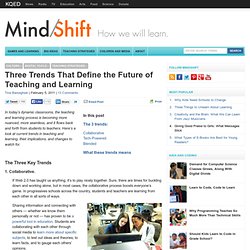

Four Key Ways Education will Change. When Testing Takes Over. My top 10 quotes on change. The Learning Nation: What Story Does Your Timetable Tell? Start at 8:30.

Four blocks per day, frozen schedule. 80 minutes each. Nutrition break in the mid morning. 50 minute lunch. End sometime around 3. Monday to Friday. Change courses at the end of January. Start at 8:55. 9 periods per day, tumbling schedule. 45 minutes each. Start at 8:35. Whatever. I am sure that there are other permutations of the high school schedule, and others of elementary and middle schools, but I would guess that most timetables out there don't look too terribly different than one of these.
What I like about this form is that it includes priorities, non-negotiables, and a reflection piece for me to understand better how some of our faculty might perceive our non-negotiables and perhaps have suggestions that might make them easier to understand and work with. School Is a Prison — And Damaging Our Kids. Photo Credit: Shutterstock.com/Goodluz August 30, 2013 | Like this article?

Join our email list: Stay up to date with the latest headlines via email. Parents send their children to school with the best of intentions, believing that’s what they need to become productive and happy adults. But what if the real problem is school itself? School is a place where children are compelled to be, and where their freedom is greatly restricted — far more restricted than most adults would tolerate in their workplaces. Compulsory schooling has been a fixture of our culture now for several generations. Schools as we know them today are a product of history, not of research into how children learn. When schools were taken over by the state and made compulsory, and directed toward secular ends, the basic structure and methods of schooling remained unchanged.
It’s no wonder that, today, even the “best students” (maybe especially them) often report that they are “burned out” by the schooling process. What Does It Mean To Be A Change Leader in Education? Over the past 20 years, I have studied and worked with educators who have aspired to be change leaders in a wide variety of schools in the US and elsewhere.

The most effective of these change leaders – whether they are classroom teachers, principals, or systems leaders – share a number of common practices. First, successful change leaders clearly articulate the need for change to a variety of audiences in ways that are intellectually coherent and emotionally compelling. The ability to do this requires that change leaders immerse themselves into radically different worlds. The first world that change leaders must understand deeply is the world for which they are preparing their students. Effective change leaders clearly understand and communicate what will be demanded of their graduates – what skills, what habits of mind, and what dispositions. Cultivating a Positive Environment for Students. How well does your school meet student expectations? Take this quiz to find out.
Geoffrey Canada: Our failing schools. Enough is enough! School improvement. Kotter International - The 8-Step Process for Leading Change. Andreas Schleicher: Use data to build better schools. 4 Ways to Transform Your School Culture. In a traditional high school, students sit at their desks and listen to their English teacher talk about Rip Van Winkle's adventure in the Catskill Mountains.

They hear that the man in Washington Irving's short story fell asleep for 20 years, and when he returned to his village, he found that everything had changed. His wife had died, his close friends were gone, and the American colonies had thrown off the shackles of British authority. Once the bell rang, the students walked to math class, sat through another lecture and left the building at 2:30 p.m. This day was much like many others in their academic career. Little in their routine had changed over the years, as is the case for most schools today, said Patrick Larkin, the principal of Burlington High School in Massachusetts. “If you woke up and walked into modern society, the one place you’d recognize clearly is a public school,” he said. Three Trends That Define the Future of Teaching and Learning. Culture Digital Tools Teaching Strategies In today’s dynamic classrooms, the teaching and learning process is becoming more nuanced, more seamless, and it flows back and forth from students to teachers.

Here’s a look at current trends in teaching and learning, their implications, and changes to watch for. The Three Key Trends. 30 Goals 2012. 10 Simple Ideas for Transforming Your Teaching This School Year. Posted by Shelly Terrell on Sunday, August 26th 2012 “Education is not the filling of a pail, but the lighting of a fire.”~ William Butler Yeats Many of us will face many new learners as a new semester of classes begin.

For many of us this can be a frightening and stressful experience. It should be. We have an enormous responsibility as educators to inspire our students to be continuous learners, explore their curiosities, and search for possibilities to problems that need to be solved. Unfortunately, the system isn’t exactly cut out to support students in exploration.